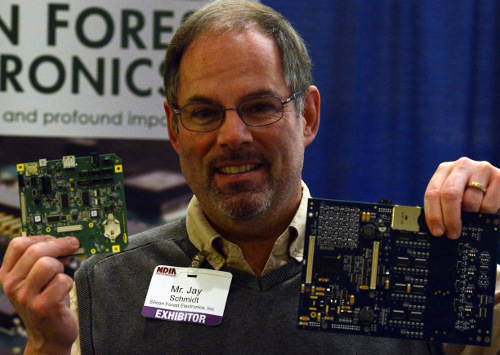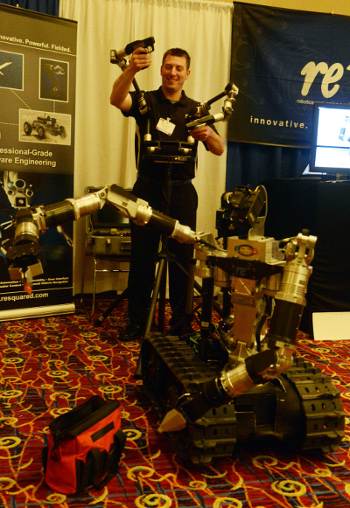 |
| June 02, 2015 | Volume 11 Issue 21 |
Designfax weekly eMagazine
Archives
Partners
Manufacturing Center
Product Spotlight
Modern Applications News
Metalworking Ideas For
Today's Job Shops
Tooling and Production
Strategies for large
metalworking plants
'Better buying power' key to maintaining Army tech edge
By David Vergun, U.S. Army
If the Army is to maintain its technological edge over potential adversaries, it must improve the way it conducts business with industry partners, said one of the service's top acquisition experts.
A key step toward that improvement is Better Buying Power 3.0, or BBP 3.0, said Kevin Fahey, director of system of systems engineering and integration within the office of the assistant secretary of the Army for acquisition, logistics, and technology. He spoke April 8 during a robotics conference sponsored by the National Defense Industrial Association.

Jay Schmidt displays the printed circuit board assemblies that his company, Silicon Forest Electronics, makes. [Photo Credit: David Vergun]
Better Buying Power 3.0 is the currently-under-development revision of best practices designed to strengthen the Defense Department's buying power, improve industry productivity, and provide an affordable, value-added military capability to the warfighter.
Looking back at BBP 2.0, Fahey said the thrust of the older version was providing guidance to program managers "on what to put in contracts."
The focus of BBP 3.0 expands that to help all those who execute contracts, including program managers, program executive officers, and industry professionals.
Understanding MOSA
Fahey said an important aspect of BBP 3.0 is "modular open systems architecture," or MOSA.
Compliance with MOSA requires software and hardware components to be effectively partitioned in their design and functioning so they can be isolated if there are problems, or swapped out with minimal effort and cost if new components become available.
Details on the human-machine and machine-machine interfaces need to be published as well, Fahey said, and must be understood and communicated between industry and Army engineers.
Another aspect is that comprehensive but easily understood training manuals on how the system works -- including the in- and out-processing -- must be provided to Army maintainers and operators, he said.
The tools and standards used to implement MOSA must also be shared between the prime contractor and all of the subcontractors as well, he said.
Full MOSA guidance will be published and implemented Dec. 31, 2015, he said.

Aaron Nicely of RE2, Inc., shows how to control his robot to unzip a purse and retrieve a bomb. [Photo Credit: David Vergun]
Peering into the black box
Fahey, who has a background in systems engineering, said he has received a lot of formal input from industry on MOSA standards.
One of the biggest concerns from industry regarding compliance with MOSA standards, he said, is the possibility of the unauthorized release of proprietary data to competitors.
Fahey said that as long as "black box" components can be easily removed and replaced when damaged or when an upgrade is needed, and as long as the "architecture and interfaces are right and it functions -- I don't need to know what's in the black box."
Being able to easily remove such components is also important to lowering sustainment costs, Fahey said. Currently, the Army has many "stove-piped" legacy systems that are difficult to upgrade because they don't conform to MOSA standards, he said, and parts can't easily be pulled out and replaced.
Getting to VICTORY
Another important aspect of BBP 3.0 is getting industry to "VICTORY" compliance, Fahey said.
VICTORY is short for "Vehicle Integration for C4ISR/EW Interoperability," where C4ISR means "command, control, communications and computers, intelligence, surveillance, and reconnaissance," and EW is short for "electronic warfare."
Getting the common electronic interfaces between vehicles and C4ISR/EW is the thrust of VICTORY, he said.
Currently, geospatial data use, such as terrain, is displayed five different ways, depending on which system is used, he said. VICTORY compliance would give Soldiers in their vehicles or aircraft and those back at the headquarters element the same real-time operating picture.
Fahey put up a slide that showed five images that looked like five different versions of Google Earth of the same location, illustrating how hard it now is for operators to communicate and share what they are seeing.
Soldiers in Bradleys, Abrams, and Strykers are seeing different visuals, and that should not be, he said.
Having the same operator picture is necessary for navigation, timing, and mission command, he said. Implementing VICTORY will also increase cyber security as there will be one system to protect, verses multiple systems.
Published June 2015
Rate this article
View our terms of use and privacy policy
